While several neighborhood merchants were sounding the alarm, the mayor of Montreal unveiled the action plan for the Village of the Ville-Marie district last Thursday.
After listening to the mayor and taking note of the recommendations, I have to honestly say that the result is very disappointing. A few months after the City Ombudsman criticized elected officials for continuing with the same approach they knew was ineffective in dealing with homelessness, I would have expected that we would be offered a change of course rather than further remedial action . A few months after the UMQ mission to Finland, led by Mayor Bruno Marchand, who refused to see homelessness as inevitable, I would have expected the mayor to have something to say to us other than teach us to live with homelessness and portray them as normal proximity to downtown.
I must also say that the portrayal of the situation shows social hypocrisy. Representing the severe social problems that have been shoveled in this district for decades as “village social problems” means presenting the situation as if they originated in the village while affecting it due to actions of successive municipal governments .
Having seen all the revitalization projects for the district’s micro-districts and the city’s interventions to address the social problems of the street for more than a quarter of a century as a publisher, I realize that their growth in the Village is through the revitalization of the Faubourg St-Laurent and then the Quartier des Spectacles connected directly to the settlement east of all roadsides.
Failed Solutions
Several researchers have documented this process. The police repression was deliberately used by the authorities at the time to “clean up” the former red light. I remember all too well the police action in Émilie-Gamelin in the late 1990s to evict young people from the streets who were being sent back to the village. They had then settled in Beaudry Metro Park and Campbell Park.
I also remember the crazy street prostitution diversion project proposed by the city in 1999-2000 to rid other neighborhoods of this phenomenon by concentrating it in Centre-Sud. The city relented in the face of popular outcry, but remained deaf to citizens’ concerns that the neighborhood was becoming a large concentration of “street clientele” resources.
It doesn’t take Papineau’s head to understand that we’re setting up a joyful storm as we set up resources around the village for all street customers, including two monitored injection sites. But when you have big revitalization projects that cost hundreds of millions of dollars, you find it perfectly normal to push these people further East, and you tell yourself that gay people are tolerant and marginalized and that the Village is not a family neighborhood. Therefore, it is less problematic to solve these problems there.
Systemic Discrimination
Our community is well aware of this “clean up” by local governments over the decades. It was precisely the repression that preceded the Olympics that caused gay establishments to relocate to what is now the Village. When the mayor speaks about the struggles in our communities, it is certainly embarrassing to remember that these are often waged against the city government and its police department.
As the city recognizes the existence of systemic discrimination, it questions its propensity to require our communities to live with what would be unbearable in other neighborhoods. Apart from the declarations of love for the village by our elected officials, all we can say is that it is the last pole of the district awaiting a revitalization project.
For decades, community organizations and researchers alike have been demanding that we no longer settle for opening emergency shelters or day centers and teams of roadworkers, but that we provide supervised housing for those who wish to get off the streets. In order to be able to intervene effectively, it is necessary to stabilize people and create the conditions for follow-up. This inevitably includes the provision of a roof. Finland’s experience, which Mayor Marchand examined this winter, is conclusive in this regard.
More than 60 years after the Quiet Revolution, it is high time our governments stopped relying on Christian charities and community organizations to deal with these social problems. It is pathetic that we are still dependent on these resources, which for all their goodwill are insufficient and, above all, not suitable for psychosocial follow-up care over the years.
Many will say that such a shift in direction will take years to have an impact and that short-term results are needed. I’ve heard that argument for at least 25 years. And short-term damage control measures are here. Maybe it would be different if we had changed course 25 years ago.
Andre Gagnon, Publisher, GQ Guides


